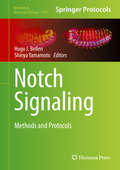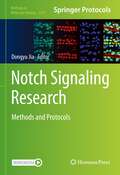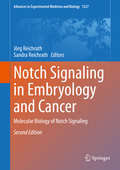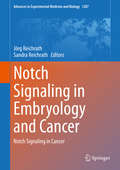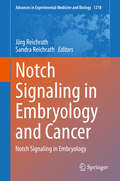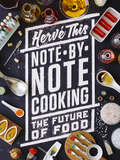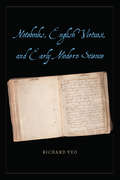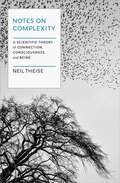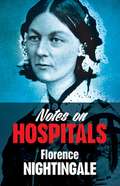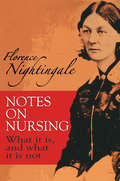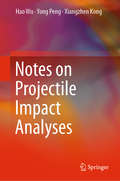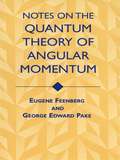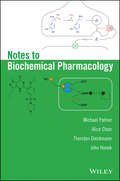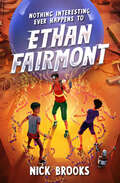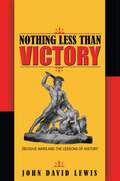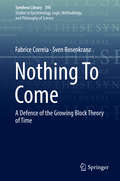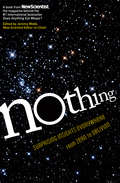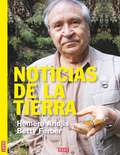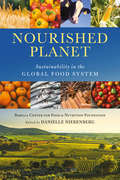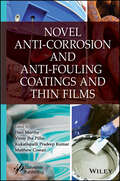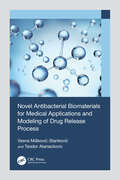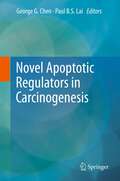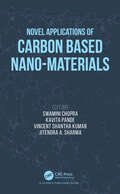- Table View
- List View
Notch Signaling
by Hugo J. Bellen Shinya YamamotoNotch Signaling: Methods and Protocols focuses on molecular, biochemical and bioinformatics aspects of Notch signaling. Chapters analyze the Notch interactome, post-translational modifications of Notch, ligand binding assays, methods to assess proteolytic cleavage and transcriptional targets. Written in the highly successful Methods in Molecular Biology series format, chapters include introductions to their respective topics, lists of the necessary materials and reagents, step-by-step, readily reproducible laboratory protocols and key tips on troubleshooting and avoiding known pitfalls. Authoritative and practical, Notch Signaling: Methods and Protocols is a valuable contribution to hundreds of labs and thousands of scientists who pursue this research area with vigor.
Notch Signaling Research: Methods and Protocols (Methods in Molecular Biology #2472)
by Dongyu JiaThis detailed volume explores the large research area of Notch signaling studies in a variety of model organisms. The collected research methods and protocols include the dissection of Notch functional sites, Notch regulators, Notch activity reporters and analysis, roles of Notch in development and diseases, wet and dry lab tools and studies, and bioinformatics analysis. This book particularly emphasizes on the exploration of Notch roles in development and diseases, while acknowledging the importance of combining classic and novel molecular tools and methods, bioinformatics workflows and applications, and different model organisms to fully understand the subject area. Written for the highly successful Methods in Molecular Biology series, chapters include introductions to their respective topics, lists of the necessary materials and reagents, step-by-step, readily reproducible laboratory protocols, and tips on troubleshooting and avoiding known pitfalls. Authoritative and cutting-edge, Notch Signaling Research: Methods and Protocols is an ideal guide for researchers in the field, with techniques that could potentially be applied to study the wider world of other signaling pathways as well.
Notch Signaling in Embryology and Cancer: Molecular Biology of Notch Signaling (Advances in Experimental Medicine and Biology #1227)
by Jörg Reichrath Sandra ReichrathThis thoroughly revised second edition is an up-to-date overview of the current knowledge of Notch and Notch signaling in embryology and cancer. It summarizes the newest achievements on this topic from Notch’s flag-ship function in the development of the embryo and for various inherited diseases to the Notch signaling pathway’s role in the development of leukemia and in a number of cancers, including skin cancer, intestinal cancer and others. Additionally, the emerging new role of the Notch signaling pathway as a promising target for prevention and therapy of various diseases, including cancer, is discussed. In the years since the previous edition, there have been numerous developments and insights within this rapidly moving field, making this new edition urgently needed. This volume also features discussions of current insights on Notch’s role for embryologic tissue patterning, for stem cells, in senescence, and on the regulation of Notch signaling by epigenetic and other factors including microRNAs, long non-codingRNAs, and more. Taken as a whole, with its companion books – Notch Signaling in Embryology and Notch Signaling in Cancer – this is a definitive discussion of the topic, presented by internationally-recognized contributors. Presented in a coherent and accessible structure, this revised and updated second edition is an essential and up-to-date guide for oncologists, embryologists, researchers and advanced students.
Notch Signaling in Embryology and Cancer: Notch Signaling in Cancer (Advances in Experimental Medicine and Biology #1287)
by Jörg Reichrath Sandra ReichrathThis thoroughly revised second edition is an up-to-date overview of the current knowledge of Notch and Notch signaling in embryology and cancer. It discusses this topic from Notch’s role in the development of the embryo to the Notch signaling pathway’s role in the development of a number of cancers, including breast cancer, malignant melanoma, Non-melanoma skin cancer, intestinal cancer and others. In the years since the previous edition, there have been numerous developments and insights within this rapidly moving field, making this new edition urgently needed. This volume also features discussions of current insights on Notch’s role in senescence, the regulation of Notch signaling by microRNAs, Notch’s role in the microbiome, diet and its influence on Notch signaling and more. Taken as a whole, with its companion books -- Notch Signaling and Embryologic Development and Molecular Basis of Notch Signaling – this is a definitive discussion of the topic, presented by internationally-recognized contributors. Presented in a coherent and accessible structure, this revised and updated second edition is an essential and up-to-date guide for oncologists, embryologists, researchers and advanced students.
Notch Signaling in Embryology and Cancer: Notch Signaling in Embryology (Advances in Experimental Medicine and Biology #1218)
by Jörg Reichrath Sandra ReichrathThis thoroughly revised second edition is an up-to-date overview of the current knowledge of Notch and Notch signaling in embryology and cancer. It discusses this topic from Notch’s role in the development of the embryo to the Notch signaling pathway’s role in the development of a number of cancers, including breast cancer, malignant melanoma, Non-melanoma skin cancer, intestinal cancer and others. In the years since the previous edition, there have been numerous developments and insights within this rapidly moving field, making this new edition urgently needed. This volume also features discussions of current insights on Notch’s role in senescence, the regulation of Notch signaling by microRNAs, Notch’s role in the microbiome, diet and its influence on Notch signaling and more. Taken as a whole, with its companion books – Molecular Biology of Notch Signaling and Notch Signaling in Cancer – this is a definitive discussion of the topic, presented by internationally-recognized contributors. Presented in a coherent and accessible structure, this revised and updated second edition is an essential and up-to-date guide for oncologists, embryologists, researchers and advanced students.
Note-by-Note Cooking: The Future of Food (Arts and Traditions of the Table: Perspectives on Culinary History)
by Hervé ThisNote-by-Note Cooking is a landmark in the annals of gastronomy, liberating cooks from the constraints of traditional ingredients and methods through the use of pure molecular compounds. 1-Octen-3-ol, which has a scent of wild mushrooms; limonene, a colorless liquid hydrocarbon that has the smell of citrus; sotolon, whose fragrance at high concentrations resembles curry and at low concentrations, maple syrup or sugar; tyrosine, an odorless but flavorful amino acid present in cheese—these and many other substances, some occurring in nature, some synthesized in the laboratory, make it possible to create novel tastes and flavors in the same way that elementary sound waves can be combined to create new sounds. Note-by-note cooking promises to add unadulterated nutritional value to dishes of all kinds, actually improving upon the health benefits of so-called natural foods. Cooking with molecular compounds will be far more energy efficient and environmentally sustainable than traditional techniques of cooking. This new way of thinking about food heralds a phase of culinary evolution on which the long-term survival of a growing human population depends. Hervé This clearly explains the properties of naturally occurring and synthesized compounds, dispels a host of misconceptions about the place of chemistry in cooking, and shows why note-by-note cooking is an obvious—and inevitable—extension of his earlier pioneering work in molecular gastronomy. An appendix contains a representative selection of recipes, vividly illustrated in color.
Notebooks, English Virtuosi, and Early Modern Science
by Richard YeoIn Notebooks, English Virtuosi, and Early Modern Science, Richard Yeo interprets a relatively unexplored set of primary archival sources: the notes and notebooks of some of the leading figures of the Scientific Revolution. Notebooks were important to several key members of the Royal Society of London, including Robert Boyle, John Evelyn, Robert Hooke, John Locke, and others, who drew on Renaissance humanist techniques of excerpting from texts to build storehouses of proverbs, maxims, quotations, and other material in personal notebooks, or commonplace books. Yeo shows that these men appreciated the value of their own notes both as powerful tools for personal recollection, and, following Francis Bacon, as a system of precise record keeping from which they could retrieve large quantities of detailed information for collaboration. The virtuosi of the seventeenth century were also able to reach beyond Bacon and the humanists, drawing inspiration from the ancient Hippocratic medical tradition and its emphasis on the gradual accumulation of information over time. By reflecting on the interaction of memory, notebooks, and other records, Yeo argues, the English virtuosi shaped an ethos of long-term empirical scientific inquiry.
Notes On Complexity: A Scientific Theory Of Connection, Consciousness, And Being
by Neil Theise2024 Nautilus Book Award Winner * The Marginalian Favorite Books of 2023 An electrifying introduction to complexity theory, the science of how complex systems behave, that explains the interconnectedness of all things and that Deepak Chopra says, “will change the way you understand yourself and the universe.” Nothing in the universe is more complex than life. Throughout the skies, in oceans, and across lands, life is endlessly on the move. In its myriad forms—from cells to human beings, social structures, and ecosystems—life is open-ended, evolving, unpredictable, yet adaptive and self-sustaining. Complexity theory addresses the mysteries that animate science, philosophy, and metaphysics: how this teeming array of existence, from the infinitesimal to the infinite, is in fact a seamless living whole and what our place, as conscious beings, is within it. The implications of complexity theory are profound, providing insight into everything from the permeable boundaries of our bodies to the nature of consciousness. Notes on Complexity is an invitation to trade our limited, individualistic view for the expansive perspective of a universe that is dynamic, cohesive, and alive—a whole greater than the sum of its parts. Physician, scientist, and philosopher Neil Theise takes us to the exhilarating frontiers of human knowledge and in the process restores wonder and meaning to our experience of the everyday.
Notes of an Alchemist
by Loren C. EiseleyPoems on crystals, birds, the outdoors and all aspects of nature.
Notes on Hospitals: Being Two Papers Read Before The National Association For The Promotion Of Social Science, At Liverpool, In October 1858
by Florence NightingaleThe founder of modern nursing expressed her revolutionary ideas of hospital reform in these two essays, published in 1859 and presented the previous year at the Social Science Congress. During the Crimean War, Florence Nightingale achieved renown as The Lady with the Lamp, the tireless caretaker of wounded soldiers. Afterward, Nightingale searched Europe for innovations to help the army improve its hospital care. This report of her findings and suggestions had a profound effect on the medical community and reestablished the author as an international healthcare authority.Despite the advances in medical knowledge since Nightingale's era, her common-sense approach continues to form a solid foundation for nursing. In these essays she voices the importance of hygiene―fresh air and water, cleanliness, proper drainage, and ample light―as well as ongoing consideration for patients' feelings. Nightingale's ability to effectively articulate her ideas impressed her contemporaries and continues to influence modern readers. This volume serves as a companion to Nightingale's classic of nursing literature, Notes on Nursing: What It Is, and What It Is Not.
Notes on Nursing: What It Is, and What It Is Not (Dover Books on Biology)
by Florence Nightingale"My heart always sinks within me when I hear the good housewife, of every class, say, 'I assure you the bed has been well slept in: and I can only hope it is not true. What? Is the bed already saturated with somebody else's damp before my patient comes to exhale in it his own damp? Has it not had a single chance to be aired? No, not one. It has been slept in every night."From the best known work of Florence Nightingale (1820-1910), the originator and founder of modern nursing, comes a collection of notes that played an important part in the much needed revolution in the field of nursing. For the first time it was brought to the attention of those caring for the sick that their responsibilities covered not only the administration of medicines and the application of poultices, but the proper use of fresh air, light, warmth, cleanliness, quiet, and the proper selection and administration of diet. Miss Nightingale is outspoken on these subjects as well as on other factors that she considers essential to good nursing. But, whatever her topic, her main concern and attention is always on the patient and his needs.One is impressed with the fact that the fundamental needs of the sick as observed by Miss Nightingale are amazingly similar today (even though they are generally taken for granted now) to what they were over 100 years ago when this book was written. For this reason, this little volume is as practical as it is interesting and entertaining. It will be an inspiration to the student nurse, refreshing and stimulating to the experienced nurse, and immensely helpful to anyone caring for the sick.
Notes on Projectile Impact Analyses
by Hao Wu Yong Peng Xiangzhen KongThis book presents comprehensive experimental, numerical, and theoretical research on projectile impact analysis, such as the rigid projectile penetration/perforation of concrete and metallic targets, and shaped-charge-formed projectile and jet penetrations. Concrete and metal materials are widely used in protective structures in both civil engineering and armored vehicles, such as military fortifications, underground shelters, infantry fighting vehicles, and tanks, which are designed to withstand intentional or accidental impact loadings caused by projectiles and fragments, and the responses of these targets under projectile impact have been a topic of discussion for several decades. Written for researchers and engineers working in the fields of protective structures and high-speed penetration mechanics, the book is also a valuable reference for senior undergraduate and postgraduate students majoring in defense engineering, terminal ballistics and other related fields.
Notes on the Quantum Theory of Angular Momentum
by Eugene Feenberg George Edward PakeThis classic, concise text has served a generation of physicists as an exceptionally useful guide to the mysteries of angular momenta and Clebsch-Gordon Coefficients. Derived from notes originally prepared to assist graduate students in reading research papers on atomic, molecular, and nuclear structure, the text first reviews the basic elements of quantum theory. It then examines the development of the fundamental commutation relations for angular momentum components and vector operators, and the ways in which matrix elements and eigenvalues of the angular momentum operators are worked out from the commutation relations.These chapters constitute a review on an elementary level of material usually included in a one-year course in quantum theory. In the second half of the text, the matrix elements of scalar, vector, and tensor operators are computed and applied to derive several useful relations in the theory of magnetic moments, electric quadruple moments, and dipole transition probabilities. Eschewing all that is irrelevant, this book focuses on the essentials and prepares readers for further study in the field. A helpful list of references concludes the work.
Notes to Biochemical Pharmacology
by Michael Palmer Alice Chan Thorsten Dieckmann John HonekAn integrated approach to the study of drug action mechanismsBiochemical Pharmacology is a concise and contemporary textbook on the principles of drug action. It discusses representative drugs by example to explore the range of biochemical targets and mechanisms. The book explains some of the experiments that tell us how drugs work, and it outlines the physiological and pathological context that make those action mechanisms therapeutically useful.Biochemical Pharmacology is intended primarily for students in biology and biochemistry at the advanced undergraduate or graduate levels. For classroom use, the illustrations from the book are separately available as PowerPoint slides. It is written in a conversational, vivid style that readily encourages students to explore this important area of medical science. Biochemical Pharmacology can also serve as an introduction for professionals in biosciences, as well as in pharmaceutical and health sciences.Complete with numerous figures throughout the text, which are also available separately as PowerPoint slides, Biochemical Pharmacology:Explains the role of pharmacodynamics, pharmacokinetics, and drug metabolism in drug actionProvides representative examples from the pharmacology of cell excitation, hormones, nitric oxide, chemotherapy, and othersExamines emerging applications of ribonucleic acids as drugs and drug targetsDiscusses what researchers need to know about the problems of drug distribution, elimination, and toxicityBiochemical Pharmacology is an important resource for anyone wishing to gain an in-depth understanding of drug action mechanisms and extremely useful for researchers wishing to explore some of the unanswered questions.
Nothing Happens: Chantal Akerman’s Hyperrealist Everyday
by Ivone MarguliesThrough films that alternate between containment, order, and symmetry on the one hand, and obsession, explosiveness, and a lack of control on the other, Chantal Akerman has gained a reputation as one of the most significant filmmakers working today. Her 1975 film Jeanne Dielman, 23 Quai du Commerce, 1080 Bruxelles is widely regarded as the most important feminist film of that decade. In Nothing Happens, Ivone Margulies presents the first comprehensive study of this influential avant-garde Belgian filmmaker.Margulies grounds her critical analysis in detailed discussions of Akerman's work--from Saute ma ville, a 13-minute black-and-white film made in 1968, through Jeanne Dielman and Je tu il elle to the present. Focusing on the real-time representation of a woman's everyday experience in Jeanne Dielman, Margulies brings the history of social and progressive realism and the filmmaker's work into perspective. Pursuing two different but related lines of inquiry, she investigates an interest in the everyday that stretches from postwar neorealist cinema to the feminist rewriting of women's history in the seventies. She then shows how Akerman's "corporeal cinema" is informed by both American experiments with performance and duration and the layerings present in works by European modernists Bresson, Rohmer, and Dreyer. This analysis revises the tired opposition between realism and modernism in the cinema, defines Akerman's minimal-hyperrealist aesthetics in contrast to Godard's anti-illusionism, and reveals the inadequacies of popular characterizations of Akerman's films as either simply modernist or feminist. An essential book for students of Chantal Akerman's work, Nothing Happens will also interest international film critics and scholars, filmmakers, art historians, and all readers concerned with feminist film theory.
Nothing Interesting Ever Happens to Ethan Fairmont (Ethan Fairmont)
by Nick BrooksE.T. meets Stranger Things in this middle-grade novel series from author and award-winning filmmaker Nick Brooks. With crossover appeal, this fun, engaging series has plenty of nostalgia nods for adults to appreciate as well as young readers. Something cool happening in Ferrous City? Not a chance. Until one day . . . when self-proclaimed genius inventor Ethan Fairmont runs into an abandoned car factory to avoid a local bully and accidentally stumbles across his ex–best friend Kareem, new kid Juan Carlos, and an extraterrestrial visitor. Cheese (the alien) is stuck on Earth and in need of some serious repairs, spicy snacks—and absolute, total secrecy. That&’s easier said than done when mysterious agents descend on Ferrous City to search for Cheese. With time running out and their family and friends in potential danger, can Ethan, Kareem, and Juan Carlos pull off an intergalactic rescue before they&’re all found out? Weaving issues of racial profiling, community struggles, and everyday life in a fast-paced science fiction adventure, Brooks&’s debut middle-grade series is destined to be a favorite out-of-this-world adventure for kids 9–12. A timely—and timeless—sci-fi epic for fans of Tristen Strong Punches a Hole in the Sky and the Artemis Fowl series. Hardcover with dust jacket; 240 pages; 5.5 x 8.3 in
Nothing Less than Victory: Decisive Wars and the Lessons of History
by John David LewisHow aggressive military strategies win wars, from ancient times to todayThe goal of war is to defeat the enemy's will to fight. But how this can be accomplished is a thorny issue. Nothing Less than Victory provocatively shows that aggressive, strategic military offenses can win wars and establish lasting peace, while defensive maneuvers have often led to prolonged carnage, indecision, and stalemate. Taking an ambitious and sweeping look at six major wars, from antiquity to World War II, John David Lewis shows how victorious military commanders have achieved long-term peace by identifying the core of the enemy's ideological, political, and social support for a war, fiercely striking at this objective, and demanding that the enemy acknowledges its defeat.Lewis examines the Greco-Persian and Theban wars, the Second Punic War, Aurelian's wars to reunify Rome, the American Civil War, and the Second World War. He considers successful examples of overwhelming force, such as the Greek mutilation of Xerxes' army and navy, the Theban-led invasion of the Spartan homeland, and Hannibal's attack against Italy—as well as failed tactics of defense, including Fabius's policy of delay, McClellan's retreat from Richmond, and Chamberlain's appeasement of Hitler. Lewis shows that a war's endurance rests in each side's reasoning, moral purpose, and commitment to fight, and why an effectively aimed, well-planned, and quickly executed offense can end a conflict and create the conditions needed for long-term peace.Recognizing the human motivations behind military conflicts, Nothing Less than Victory makes a powerful case for offensive actions in pursuit of peace.
Nothing To Come: A Defense Of The Growing Block Theory Of Time (Synthese Library #395)
by Fabrice Correia Sven RosenkranzThis monograph is a detailed study, and systematic defence, of the Growing Block Theory of time (GBT), first conceived by C.D. Broad. The book offers a coherent, logically perspicuous and ideologically lean formulation of GBT, defends it against the most notorious objections to be found in the extant philosophical literature, and shows how it can be derived from a more general theory, consistent with relativistic spacetime, on the pre-relativistic assumption of an absolute and total temporal order.The authors devise axiomatizations of GBT and its competitors which, against the backdrop of a shared quantified tense logic, significantly improves the prospects of their comparative assessment. Importantly, neither of these axiomatizations involves commitment to properties of presentness, pastness or futurity. The authors proceed to address, and defuse, a number of objections that have been marshaled against GBT, including the so-called epistemic objection according to which the theory invites skepticism about our temporal location. The challenge posed by relativistic physics is met head-on, by replacing claims about temporal variation by claims about variation across spacetime.The book aims to achieve the greatest possible rigor. The background logic is set out in detail, as are the principles governing the notions of precedence and temporal location. The authors likewise devise a novel spacetime logic suited for the articulation, and comparative assessment, of relativistic theories of time. The book comes with three technical appendices which include soundness and completeness proofs for the systems corresponding to GBT and its competitors, in both their pre-relativistic and relativistic forms. The book is primarily directed at researchers and graduate students working on the philosophy of time or temporal logic, but is of interest to metaphysicians and philosophical logicians more generally.
Nothing: Surprising Insights Everywhere from Zero to Oblivion
by David Fisher Paul Davies Ian Stewart Michael Brooks David Harris Jo Marchant Linda Geddes Jonathan Knight Nigel Henbest Stephen Battersby Marcus Chown Laura Spinney Michael de Podesta NewScientist Douglas Fox Per Eklund Valerie Jamieson Rick A. Lovett Andy CoghlanThe writers behind New Scientist explore the baffling concept of nothingness from the fringes of the universe to our minds&’ inner workings. It turns out that nothing is as curious or as enlightening as nothingness itself. What is nothing? Where can it be found? The writers of the world&’s top-selling science magazine investigate—from the big bang, dark energy, and the void, to superconductors, vestigial organs, hypnosis, and the placebo effect. And they discover that understanding nothing may be the key to understanding everything: What came before the big bang—and will our universe end?How might cooling matter down almost to absolute zero help solve our energy crisis?How can someone suffer from a false diagnosis as though it were true?Does nothingness even exist if squeezing a perfect vacuum somehow creates light?Why is it unfair to accuse sloths—animals who do nothing—of being lazy?And more! Contributors Paul Davies, Jo Marchant, and Ian Stewart, along with two former editors of Nature and sixteen other leading writers and scientists, marshal up-to-the-minute research to make one of the most perplexing realms in science dazzlingly clear. Prepare to be amazed at how much more there is to nothing than you ever realized.
Noticias de la Tierra
by Homero Aridjis"El Grupo de los Cien es un movimiento de conciencia que trata de cambiar nuestra relación con la naturaleza. Gracias a este grupo, presidido por el santo poeta Homero Aridjis, todavía podemos disfrutar en nuestro mundo de la magia de la mariposa monarca, la tortuga marina y la ballena gris." Alejandro Jodorowsky El fundador del Grupo de los Cien nos entrega una obra invaluable sobre las acciones que esta organización ha llevado a cabo en favor de la protección del ambiente. Al mismo tiempo, nos conduce en un recorrido a través de las bellezas naturales de México, muestras de su enorme biodiversidad. Así, se develan maravillas como el cardón gigante, la tortuga marina, la ballena gris, la mariposa monarca, las Grutas del Tiempo, Cuatro Ciénegas o la selva Lacandona. En Noticias de la Tierra Homero Aridjis trata a fondo el tema de la ecología: informa, explica y denuncia lo que ha sucedido en este ámbito durante los últimos treinta años, tanto a escala nacional como internacional. Experto reconocido mundialmente, el autor narra su lucha continua contra funcionarios desinteresados y renuentes a intervenir para mejorar bosques y selvas; fauna marina y terrestre; ríos, mares y lagos.
Nourished Planet: Sustainability in the Global Food System
by Barilla Center for Food and Nutrition Danielle NierenbergMangos from India, pasta from Italy, coffee from Colombia: Every day, we are nourished by a global food system that relies on our planet remaining verdant and productive. But current practices are undermining both human and environmental health, resulting in the paradoxes of obesity paired with malnutrition, crops used for animal feed and biofuels while people go hungry, and more than thirty percent of food being wasted when it could feed the 795 million malnourished worldwide.In Nourished Planet, the Barilla Center for Food & Nutrition offers a global plan for feeding ourselves sustainably. Drawing on the diverse experiences of renowned international experts, the book offers a truly planetary perspective. Essays and interviews showcase Hans Herren, Vandana Shiva, Alexander Mueller, and Pavan Suhkdev, among many others.Together, these experts plot a map towards food for all, food for sustainable growth, food for health, and food for culture. With these ingredients, we can nourish our planet and ourselves.
Novel Anti-Corrosion and Anti-Fouling Coatings and Thin Films
by Kukatlapalli Pradeep Kumar Vinay Jha Pillai Hari Murthy Matthew CowanNanomaterials and nanocomposite materials have been developed as corrosion inhibitors and are the most noble and effective alternatives to traditional organic corrosion inhibitors. Nanomaterials provide reasonably high anticorrosive activity in both aqueous and solution phases. A unified approach to this task is lacking, however, which highlights the role of all disciplines involved in the creation and use of corrosion protection coatings for metals. Fouling is the process of accumulating unwanted material that is mostly non-living and comprised of detritus and organic or inorganic compounds, or organisms, such as tiny viruses up to giant kelps. This book covers both the processes of biofouling and anti(bio)fouling, and the devices that stop the biofouling process. This book provides a missing synopsis by providing an understanding of the anticorrosive and anti-biofouling effects of nanomaterials and nanocomposites under different environments. It features an up-to-date picture of the quality and chemistry of a substrate surface, its proper preparation by conversion treatment, the function of resins and anticorrosive pigments in paints, and novel concepts for corrosion protection.
Novel Antibacterial Biomaterials for Medical Applications and Modeling of Drug Release Process
by Vesna Mišković-Stanković Teodor AtanackovicThis book provides a comprehensive review of synthesis and physicochemical and biological characterization of novel antibacterial biomaterials produced according to original procedures and aimed at medical applications such as wound dressing, soft and hard tissue implants, drug delivery devices, and carriers for cell cultivation. It is intended for all researchers working in the fields of biomaterials and biomedical engineering, as well as medical professionals, science and engineering graduate students, academics, and industrial researchers. Includes in-depth discussions on synthesis and physicochemical characterization of novel poly vinyl alcohol-based hydrogels aimed at wound dressings and soft tissue implants Explores synthesis and physicochemical characterization of novel bioceramic hydroxyapatite-based coatings on metal surface aimed for hard tissue implants Reviews cytotoxicity and antibacterial activity of novel poly vinyl alcohol-based hydrogels aimed for wound dressing and soft tissue implants Discusses cytotoxicity and antibacterial activity of bioceramic hydroxyapatite-based coatings on metal surface aimed for hard tissue implants Provides original fractional derivative models of drug release process from hydrogels and bioceramic coatings on metal surface and explores diffusion mechanism
Novel Apoptotic Regulators in Carcinogenesis
by Paul B.S. Lai George G. ChenOur recent understanding of the cellular and molecular defects and the regulation of the apoptotic signalling pathways has resulted in rationally designed anticancer strategies and the development of novel agents that regulates apoptosis. A comprehensive review of all apoptotic-related anticancer therapies is not the purpose of this book. However, in the volume of this book with 11 chapters, we have described a number of novel apoptotic regulators that have shown promising value and also great feasibility for cancer treatment. These novel agents either occur naturally or are chemically synthesized. While we are excited about the discovery and development of these novel apoptotic regulators as potential anticancer agents, a degree of caution should be always borne in mind when interpreting the success of preclinical pro-apoptotic candidates since potential problems inevitably lie ahead. These problems usually include target specificity, unanticipated toxicity, compound stability, formulation issues, pharmacokinetic and pharmacodynamic profiles. Nevertheless, we believe that this collection of 11 chapters by established leaders in the area of apoptosis will be of great interest to not only academics working in the field of cancer research and apoptosis but also pharmaceutical and pharmacological industries that . We are looking forward to the further development to push these potential agents toward clinical stage.
Novel Applications of Carbon Based Nano-materials
by Swamini Chopra Kavita Pande Vincent Shantha Kumar Jitendra A. Sharma"There’s plenty of room at the bottom" - Richard Feynman’s legendary sentence has practically teleported the world into the age of Nano-technology over the last couple of decades. As nano-materials started drawing extensive attention, the use of nano-technology has opened many possibilities for humans. Carbon based nano-materials are an example of such prominent class of materials, which have an enormous potential to fit a wide range of applications, ranging from the energy sector to aircraft and automotive sector to bio-medical sector, etc. The book Novel Applications of Carbon Based Nano-Materials summarizes state-of-the-art studies focusing on various applications of carbon allotropes, considering the energy and environmental benefits and the socio-economic impact of the developed systems, all at the same time.
